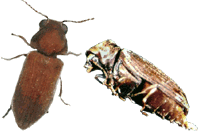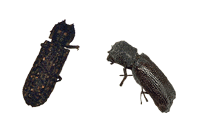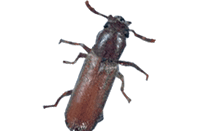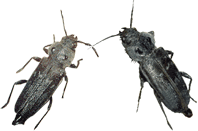Rid your home of unwanted pests with guaranteed service from Eagle Pest Control.
Eagle’s pest control maintenance service is designed to keep you home pest-free by creating a protective barrier around the exterior of your home. We use extremely effective, long-lasting products that are safe to use in homes, schools, day cares, and food service establishments. Our full-service maintenance plans are inclusive of all general household pests. You will have a pest-free environment, both inside and outside of your home or business – Guaranteed.For Service calls and pricing, please call 502-243-1600
Wood Booring Beetles

Deathwatch Beetle (Anobiids)
The deathwatch beetle is named for a tapping sound they sometimes make. Legend has it that if this sound was heard late at night by an ill person, death was near. This group of beetles includes several species, but the ones found in this area are 1/8" long, up to 1/4" long - and reddish brown or dark in color.
Deathwatch beetles are hunch-backed, with their head difficult to see from above. They are the most commonly found wood boring beetle in this area, preferring wood over 10 years old and of slightly higher moisture content. Both softwoods and hardwoods can be infested. Roughly sawn lumber is more attractive to females to lay their eggs on.
Eggs hatch into the larval stage, where the damage to wood is caused. Larva hatch and bore themselves into the wood, then turn 90 degress and go with the grain. Larva will tend to stay away from heartwoods, damaging primarily the sapwood. They don't damage a lot by themselves, but in numbers can do significant damage.
Frass is sometimes present below their holes, but not always. Deathwatch beetle frass is unique from other boring beetle frass, consisting of small pellets. Holes that are left behind are between 1/16" and 1/8" in diameter. A ballpoint pen can be inserted in the hole to identify it. If the very tip and some of the angled part go in, it's most likey a deathwatch beetle hole. Deathwatch beetles can infest a variety of structual timbers, as well as furniture and other items.
False Powderpost Beetle (Bostrichids)
False powderpost beetles are named for being sometimes confused with true powderpost beetles. They can get to be quite large, but typically the ones that infest homes are between 1/8" and 1/4" long, usually bigger than true powderpost beetles.
Coloration can range from reddish brown to brown to black. False powderpost beetles have been known to bore into soft metals on occasion. This beetle doesn't just lay their eggs on the surface, they actually bore into the wood and lay the eggs inside. Both hardwoods and softwoods are infested, but preferred is wood less than 10 years old. Sapwood is more susceptible than heartwood.
After the larva hatches they burrow into the wood, and frass gets packed into the tunnel behind them. Typically you won't see the frass in piles, as it is stuck in the beetle holes. If you do see frass, it won't be pelletized like the deathwatch beetle. But it will be similar to the true powderpost beetle, only more coarse.
The holes left are between 1/8"-1/4" in diameter. A quick test to identify a beetle hole is to insert a ball point pen. The entire tip and angled part and then some will fit into the hole with this beetle, whereas others it won't.

Powderpost Beetle (Lyctids)
True powderpost beetles are named for the flour-like powder that is produced by the larva boring into the wood. These tiny beetles are between 1/32" and 1/4" long and colored reddish brown to black. Powderpost beetles are exclusively hardwood pests, mostly of wood less than 10 years old.
They don't require quite the moisture content of other wood boring beetles. Adult beetles lay their eggs on the surface of hardwoods, in small cracks, but not on areas with paint or varnish.
Paneling, moldings, hardwood floors, cabinets, and furniture are some common things that get infested. Larva prefer to bore along the grain, and stay away from heartwood. The powdery frass and small hole size are the key features to indentifying this beetle. Frass is loose, and will fall out of holes and form piles. Larva make a hole around 1/32" to 1/16" in diameter.
To test the size, you can insert a ballpoint pen. If only the very tip goes in, it is probably a true powderpost beetle hole.

Old House Borer
The old house borers don't really live up to their names. They actually prefer to bore into wood under 10 years old. These are large beetles, between 5/8" and 1" long - colored brown to black.
Also present is a little bump on both sides, and various hairs and markings. Old house boring beetles have long antennae, being from the longhorn beetle family. Attacking exclusively softwoods such as pine, they preferr the sapwood portions over the heartwood.
Eggs are laid on the surface of the wood, and larvae bore themselves into it. The holes left from the larvae are big for beetle holes, and oddly shaped. They are between 1/4" and 3/8" in diameter, oval, and have irregular edges. Frass is packed in the holes, but some does fall out into piles. The frass consists of pellets and powdery sawdust.
During some times of the year, this beetle (as other wood borers) can be heard making clicking noises while in their holes.
Additional resources are available to assist you in identifying and controlling insects.
Insect Identification
With over 1 million identified species of insects and spiders in the world with many more still awaiting discovery. Use Insect Identification categories to discover your species.
Pest World
For expert pest control tips and resources surf to Pest World.
Pest World for Kids
For fun pest facts and kid-friendly bug and insect research, head to Pest World for Kids.
